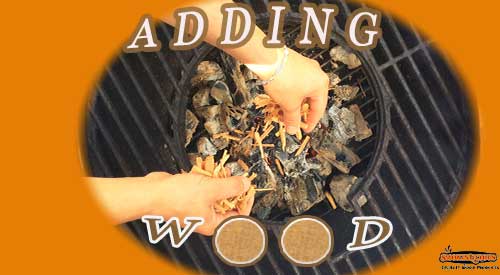Sun 10 May 2020
HOW TO USE CHARCOAL WITH WOOD IN COOKING
Posted by DonnaGRead other related stories: Charcoal Grilling , Cooking , Cooking With Wood , General Smoking Information , Smoking Tips , Smoking with chips , Smoking with chunks , Smoking with logs
No Comments

Adding grill wood chips to charcoal brings added flavor to any cooking category
HOW TO USE CHARCOAL WITH WOOD IN COOKING Share on X

The questions are quite frequent: “Since (the equipment) uses lump charcoal, do you need to add wood for smoke flavor?” “Do wood chips or chunks work best if they are needed or desired?” “Generally, how much lump charcoal does equipment use for 10 hours of smoke?”
Learn Adding Charcoal with Wood
The intent today is to give you a comfort with cooking fuel woods. That includes charwood, charcoal, smoking wood chunks, and charcoal wood chips in all shapes and sizes. Know that all these products are made from wood – hardwood to be specific since you never want to cook with any other type. But, differences do exist between products.
Product Differences
Although the products listed above have their beginnings as hardwood trees, there are some noted differences between the products.
Charcoals: Yes, charcoal starts out as wood but not all charcoals are created equally. There are 2 distinct types of charcoal: briquettes and lump hardwood. The key difference?
Briquettes are not pure charcoal but rather a combination of charcoal, coal, the starch used as a binder, sawdust, and sodium nitrate for ease of lighting. And, yes, that means they are not a “natural, organic” product. In fact, some brands are manufactured with lighter fluid as an ingredient.
Lump hardwood charcoal is 100% hardwood that is sourced from flooring, building material, sawmill, and furniture manufacturers as a scrap wood or bye product. With the use of these materials, a great deal of variation in the size of the charcoal is generated which translates to variation in carbonization of the wood. Often, there is more carbon ash in this type of charcoal but as a 100% wood product, it is viewed as a “natural” product. Keep in mind, many lump hardwood charcoals cannot be sold as a single wood type charcoal due to the production from scrap and bye product woods, so “mixed” hardwood is the general product.
Charcoals do not produce smoke or flavor. They are intended strictly for heat with the output level dependent on the brand.
Charwood: Often described as possessing the consistency of briquettes and the organic benefits of lump charcoal, charwood is a term reserved for those products that have a higher carbonization level which makes them much more efficient as a fuel source.
Smoking Wood Chunks & Smoking Wood Chips: These are pure hardwood that can be used for both heat and flavor. The difficulty? Moisture. All hardwood contains water and, depending on the level, ease of lighting and the ability to burn or combust will vary. This is the primary reason why most people do not use only wood when cooking but a combination of charcoal and wood. The bigger reason? Wood is the flavor producer!
So now that you know charcoal is for heat and hardwood is for flavor, how do you use both together for perfection in outdoor cooking?
If you have a piece of equipment that can use both, you’re on your way to an absolutely fantastic flavor.
Tips For Combining Charcoal with Wood
- When adding both charcoal and hardwood, be sure to include a water pan to the equipment as humidity increases the smoky flavoring, helps to tenderize meat by breaking down collagen, and can give a better meat yield Share on X
- A little wood goes a long way in terms of flavor so put only a few pieces to start – you can always add more
- If you intended to cook for a long time, say a muscle meat like pork shoulder, then it’s important to have unlit charcoal within the equipment so that the few pounds of lit charcoal will gradually ignite the unlit and maintain the cooking temperature
- Just like the unlit charcoal, you can place wood pieces (just a few now) along the unlit charcoal path so the flavor is also time released
- If meat/poultry juice will drip directly into the charcoal area (you have no drip pan in place) then note that this will stimulate smoke vapor off the hot coals as drippings contain sugars, proteins, oils and the ingredients used directly on the food item, meaning you may not need to use as much wood for smoky flavors
- The choice of smoking wood chunks or charcoal wood chips is total up to the cook – chunks will combust longer than charcoal chips but if you’re looking for faster combustion for smoke vapor, chips can fit that need
- Select a hardwood with a moisture level of 20-25% for maximum flavor infusion
- Amount of coals needed for the heat/temperature is dependent on the brand of charcoal, method of cooking, and equipment. A good rule of thumb is to have at least 10 lbs. available for a full day cook
Now you’re armed with the basics on cooking fuels and why a combination of products often is the best choice!
As always, we’d love to start a conversation so leave a comment.

More Related reading on this subject
For related reading:
-10 THINGS TO CONSIDER BEFORE PURCHASING WOOD FOR COOKING, GRILLING & SMOKING
-HOW TO TURN YOUR CHARCOAL GRILL INTO A SMOKER
-HOW MUCH WOOD TO ADD WHEN SMOKING
Purchase Products:
Wood Chips- Grande Sapore®
Wood Chunks- Double & Single Filet
Charwood

Dr. Smoke “A grill is just a grill until you add SmokinLicious® smoking wood chips for charcoal with wood.”